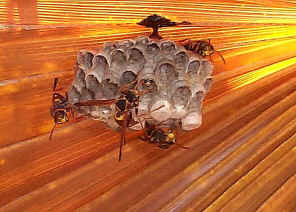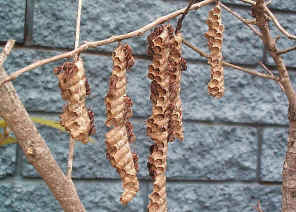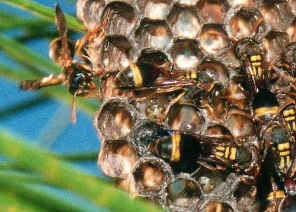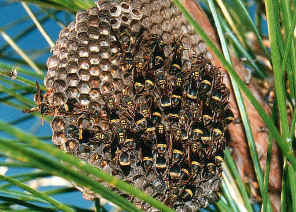|
|
FAMILY VESPIDAE, Polistinae - Paper Wasps
This page contains pictures and information about the Paper Wasps that we found in the Brisbane area, Queensland, Australia.

- Paper Wasps feed on nectar although their larvae are carnivorous.
Species in this family mostly large. Inner margins of their compound eyes usually emarginated. When rest, their fore wings often folded longitudinally, never folded horizontally.
All the social wasps are in this wasp family, although some members in this family are solitary wasps. In this family some wasps build paper nest while others build mud nest. For the social species, they have highly developed social habit. In the nest, there are the queens, males and workers. Their nests are usually attached to a tree, rock surface or building. There are different species of Paper Wasps with different nest type.
Wasp paper nests can be seen in many gardens. They can sting quite painfully and will defends their nest aggressively. Paper Wasps make their nests by chewing decayed wood mixing with their saliva. A number of hexagonal shape cup cell grouped together to form a comb. An egg is lay in each cell. The larvae develops and pupate inside the cell, emerges and become an adult.
Workers forage food, caterpillars to feed the larvae in the nest. Adult wasps feed on nectar.
- Australian native Paper Wasps belong to two groups or genera, Polistes and Ropalidia. There are two introduced species of European Paper Wasps belonging to another genus, Vespula.
- Common Paper Wasp, Australian Paper Wasp


- Polistes humilis, length 20mm
- First picture shows a Paper Wasp starts building its nest in spring. The second picture shows the established colony in mid-summer. They are social wasps living in colonies in a nest built of chewed plant tissue or "paper". They are aggressive with potent sting. They will attack and sting if nest are disturbed. More information and pictures of Paper Wasps in this page.
- Large Paper Wasp


- Polistes tepidus, body length 25mm
- We found this large wasp hunting on grass alone. This is one of the largest wasp species in Vespidae family. We took those pictures in early winter in Wishart bushland. This paper wasp species build a single horizontal comb of hexagonal paper cells nest attached by a short stalk. They are dull black in colour with orange yellow antennae and abdomen.
- Paper Wasp


- Ropalidia revolutionalis, length 10mm
- Their head, thorax, abdomen and wings are all in brown colour, with darker band on abdomen. Usually their nests consist of several adjacent combs. Each comb is about 100mm long, consist of two columns of cells. They are common in Brisbane gardens and backyards. They will attack and sting if nest are disturbed. More information please click here.
- Papernest Wasp


- Ropalidia gregaria, length 10mm
- We find this Papernest Wasps nest on road side hanging from a small pine tree about 1.5 meters above ground. The nest is flat in one layer. The wasps are brown in colour with yellow rectangular patterns on thorax, with two segments of yellow band on abdomen. Notice that some nest cells are empty, some are with larvae or pupa inside. Please click here for more pictures and information.
- Reference:
- 1. Insects of Australia, CSIRO, Division of Entomology, Melbourne University Press, 2nd Edition 1991, pp 980.
- 2. Insects of Australia and New Zealand - R. J. Tillyard, Angus & Robertson, Ltd, Sydney, 1926, p296.
